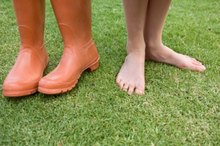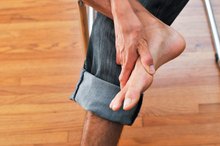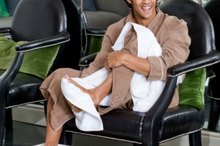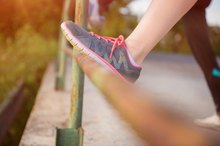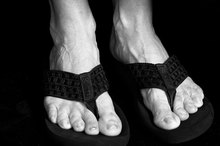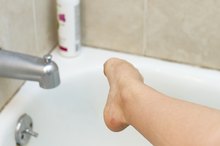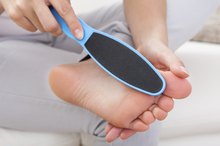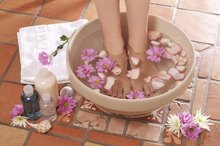How to Completely Remove Corns From Feet
When uncomfortable and ill-fitting shoes are combined with long hours of walking and standing, the inevitable result is foot pain and the strong possibility of corns. Callouses form on the feet and toes whenever they are forced against the stiff sides of shoes, and when these callouses grow inward and press against the bones of the feet and the nerve endings, pain and discomfort can result. Thankfully, corns are fairly easy to treat, and completely removing corns from feet can be accomplished in a number of ways.
If you are experiencing serious medical symptoms, seek emergency treatment immediately.
Soak Your Feet
Prepare a foot soak by mixing 1 cup of Epsom salts and 1 cup of baking soda. You may add a few drops of essential oils for a pleasing smell if you like. Peppermint or lavender are good oils to choose.
How to Remove Foot Corns Naturally
Learn More
Fill a container large enough to hold both of your feet with hot water (as hot as you can stand without burning yourself), then stir in 3 tbsp. of the foot soak mixture per gallon of water until it is dissolved. Allow to steep for 10 minutes.
Soak your feet in the water and foot soak solution for up to 30 minutes to soften the corns before you attempt to scrub them off.
- Prepare a foot soak by mixing 1 cup of Epsom salts and 1 cup of baking soda.
- of the foot soak mixture per gallon of water until it is dissolved.
Scrub Your Feet
How Does Corn Removal Work?
Learn More
Use a pumice stone specifically for smoothing feet or purchase a specialty device like the Ped Egg.
Scrub the surface of the corn with the pumice stone or Ped Egg-type device in a slow, circular motion. Press firmly, but gently, so as to not damage healthy skin around the corn.
Stop scrubbing when the healthy skin beneath the corn begins to feel stimulated by the scrubbing. This is a sign that the dead skin of the corn--which will feel numb as you scrub it--has been worn away to expose the living skin beneath.
Clean the pumice stone or Ped Egg-style device thoroughly to rid all traces of dead skin.
- Use a pumice stone specifically for smoothing feet or purchase a specialty device like the Ped Egg.
- Scrub the surface of the corn with the pumice stone or Ped Egg-type device in a slow, circular motion.
Use Corn Remover Creams or Pads
Purchase a corn pad or corn removal kit from any drug store 1.
Read the directions completely before use.
Use a horseshoe-shaped or donut-shaped corn pad that will avoid putting too much pressure directly in the center of the corn. Avoid medicated corn pads.
- Purchase a corn pad or corn removal kit from any drug store 1.
- Read the directions completely before use.
Consult a Professional
Contact a professional pedicure specialist in your area and inquire about the services offered and their effectiveness for corns.
Consult with a podiatrist if the corns are too extensive or sensitive to self-treat or eliminate with a pedicure. The doctor can explore treatment options that include medicines and surgical procedures.
Request assistance from local shoe stores to find a comfortable shoe that is fitted properly to your feet to help ease the pressure on corns and prevent new ones from forming.
Tips
The best way to deal with corns is to prevent them from forming, and the best way to do that is to simply wear comfortable shoes with a proper fit. Make sure the width of your shoes matches the width of your feet, and use narrow-toed shoes that crush the toes together on a very irregular basis.
Warnings
Be careful about using medicated corn pads as they could irritate the skin beneath the corn enough to cause infection. Be sure to soak your feet before scrubbing to soften the dead corn skin and make it easier to scrub away. Do not scrub too hard as this may damage your healthy skin and cause infection. Do not over soak your feet as this may dry out your skin and cause it to crack, which can invite injury or infection.
- Contact a professional pedicure specialist in your area and inquire about the services offered and their effectiveness for corns.
- Request assistance from local shoe stores to find a comfortable shoe that is fitted properly to your feet to help ease the pressure on corns and prevent new ones from forming.
Related Articles
References
- American Academy of Orthopaedic Surgeons: Corns
- DeLauro T and DeLauro M (2012) Chapter 98: Corns and Calluses. Fitzpatrick's Dermatology in General Medicine (8th Edition). New York, New York: McGraw-Hill Education. ISBN-13: 978-0071669047.
- American Academy of Dermatology Association. How to treat corns and calluses. 2019.
- Reddy P, Anusha T, Haritha N, Nagendra A, Bhavani D, Gandhimathi R. Case report on non-surgical treatment for foot corn. International Journal of Dermatopathology and Surgery. 2018;4(1).
- American Academy of Dermatology Association. How to Treat Corns and Calluses. 2019.
- DeLauro T and DeLauro M (2012) Chapter 98: Corns and Calluses. Fitzpatrick's Dermatology in General Medicine (8th Edition). New York, New York: McGraw-Hill Education. ISBN-13: 978-0071669047.
Tips
- The best way to deal with corns is to prevent them from forming, and the best way to do that is to simply wear comfortable shoes with a proper fit. Make sure the width of your shoes matches the width of your feet, and use narrow-toed shoes that crush the toes together on a very irregular basis.
Warnings
- Be careful about using medicated corn pads as they could irritate the skin beneath the corn enough to cause infection. Be sure to soak your feet before scrubbing to soften the dead corn skin and make it easier to scrub away. Do not scrub too hard as this may damage your healthy skin and cause infection. Do not over soak your feet as this may dry out your skin and cause it to crack, which can invite injury or infection.
Writer Bio
Eirik Ott is a professional performance poet, freelance writer, graphic designer, Apple Computer enthusiast and photographer. Since graduating from Chico State University with a degree in journalism in 2000, he has written for newspapers and magazines such as "The Reno Gazette-Journal," "The Austin American-Statesman," "Bust Magazine" and "Poets & Writers Magazine." He is based in Austin, Texas.
